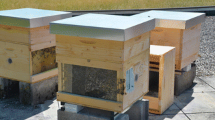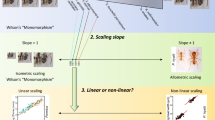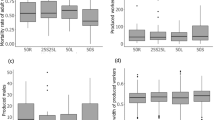Abstract
Isometric worker size variation has been found in various species of stingless bees but the adaptive value of this phenomenon is little understood. We studied intra-colony worker size variation in Melipona in relation to individual foraging preference and colony growth in periods of resource abundance and scarcity. We found significant forager size differences across colonies. In spite of this, intra-colony size of foragers collecting different resources was highly similar, suggesting that foraging preferences and flexibility are size constrained. On the other hand, inter-colony forager size was associated with parameters of colony growth, albeit differently, depending on the season. Our results suggest that isometric forager size may reflect the state of food storage, and thus, colony development in stingless bees. It seems that stingless bee communities respond to seasonal abundance and scarcity with variable cycles of individual colony growth and reduction of reserves that may explain the asynchronous reproduction of colonies, spanning years in these insects.



Similar content being viewed by others
References
Abdellatif A. 1965. Comb cell size and its effects on the body weight of the worker bee Apis mellifera L. Am. Bee J. 105: 86–87
Biesmeijer J.C. and Tóth E. 1998. Individual foraging, activity level and longevity in the stingless bee Melipona beecheii in Costa Rica (Hymenoptera, Apidae, Meliponinae). Insect. Soc. 45: 427–443
Biesmeijer J.C., van Nieuwstadt M.G.L., Lukács S. and Sommeijer M.J. 1998. The role of internal and external information in foraging decisions of Melipona workers (Hymenoptera: Meliponinae). Behav. Ecol. Sociobiol. 42: 107–116
Bullock S.H. 1999. Relationships among body size, wing size and mass in bees from a tropical dry forest in Mexico. J. Kansas Entomol. Soc. 72: 426–439
Chinh T.X., Grob G.B.J., Meeuwsen F.J.A.J. and Sommeijer M.J. 2003. Patterns of male production in the stingless bee Melipona favosa (Apidae, Meliponini). Apidologie 34: 161–170
Contrera F.A.L., Imperatriz-Fonseca V.L. and Koedam D. 2006. Age-dependent mass variation in the stingless bee Melipona quadrifasciata (Apidae, Meliponini) Braz. J. Morphol. Sci. 23: 321–324
Couvillon M.J. and Dornhaus A. 2010. Small worker bumble bees (Bombus impatiens) are hardier against starvation than their larger sisters. Insect. Soc. 57: 193–197
Gary N.E. and Lorenzen K. 1976. A method for collecting the honey-sac contents from honeybees. J. Apic. Res. 15: 73–79
Goulson D., Derwent L.C. and Peat J. 2005. Evidence for alloethism in stingless bees (Meliponinae). Apidologie 36: 411–412
Gouws J., Gaston K.J. and Chown S.L. 2011. Intraspecific body size frequency distributions of insects. PLoS ONE 6: e16606. doi:10.1371/journal.pone.0016606
Grüter C., Menezes C., Imperatriz-Fonseca V.L. and Ratnieks F.L.W. 2012. A morphologically specialized soldier caste improves colony defense in a neotropical eusocial bee. Proc. Natl Acad. Sci. USA Early edition. www.pnas.org/cgi/doi/10.1073/pnas.1113398109
Hofstede F.E. and Sommeijer M.J. 2006. Effect of food availability on individual foraging specialisation in the stingless bee Plebeia tobagoensis (Hymenoptera, Meliponini). Apidologie 37: 387–397
Kaspari M. and Vargo E.L. 1995. Colony size as a buffer against seasonality: Bergmann’s Rule in social insects. Am. Nat. 145: 610–632
Kerr W.E. and Hebling N.J.1964. Influence of the weight of worker bees on division of labor. Evolution 18: 267–270
Khoury D.S., Barron A.B. and Myerscough M.R. 2013. Modelling food and population dynamics in honey bee colonies. PLoS ONE 8: e59084. doi:10.1371/journal.pone.0059084
Kuhn-Neto B., Contrera F.A.L., Castro M.S. and Nieh J.C. 2009. Long distance foraging and recruitment by a stingless bee, Melipona mandacaia. Apidologie 40: 472–480
Levin M.D. and Haydak M.H. 1951. Seasonal variations in weight and ovarian development in worker honeybees. J. Econ. Entomol. 44: 54–57
Milne C.P. Jr. 1980. Laboratory measurement of honey production in the honeybee. 3. Pupal weight of the worker. J. Apic. Res. 19: 176–178
Milne C.P. Jr. and Pries K.J. 1984. Honey bee corbicular size and honey production. J. Apic. Res. 23: 11–14
Moo-Valle H., Quezada-Euan J.J.G. and Wenseleers T. 2001. The effect of food reserves on the production of sexual offspring in the stingless bee Melipona beecheii (Apidae, Meliponini). Insect. Soc. 48: 398–403
Nieh J.C., Contrera F.A.L., Rangel J. and Imperatriz-Fonseca V.L. 2003. Effect of food location and quality on recruitment sounds and success in two stingless bees, Melipona mandacaia and Melipona bicolor. Behav. Ecol. Sociobiol. 55: 87–94
Oliveira M.A.C. 1973. Um método para a avaliação das atividades de vôo em Plebeia saiqui (Friese) (Hymenoptera, Meliponinae). Bolm. Zool. Biol. 30: 625–631
Quezada-Euán J.J.G. 2005. Biología y uso de las abejas nativas sin aguijón de la Península de Yucatán, México (Hymenoptera: Meliponini). Ediciones de la Universidad Autónoma de Yucatán, Mérida México.
Quezada-Euán J.J.G., Paxton R.J., Palmer K.A., May-Itzá W. de J., Tay W.T. and Oldroyd B.P. 2007. Morphological and molecular characters reveal differentiation in a Neotropical social bee, Melipona beecheii (Apidae, Meliponini). Apidologie 38: 247–258
Quezada-Euán J.J.G., May-Itzá W.J., Valladares P. and De la Rúa P. 2008. Variación fenotípica en obreras y su relación con la producción de miel en colonias de Melipona beecheii B. (Hymenoptera: Meliponini). In: Memorias V Congreso Mesoamericano de abejas sin aguijón. Universidad Autónoma de Yucatán pp 106–112
Quezada-Euán J.J.G., López-Velasco A., Pérez-Balam J., Moo-Valle H., Velazquez-Madrazo A. and Paxton R.J. 2011. Body size differs in workers produced across time and is associated with variation in the quantity and composition of larval food in Nannotrigona perilampoides (Hymenoptera, Meliponini). Insect. Soc. 58: 31–38
Ramalho M., Imperatriz-Fonseca V.L. and Giannini T.C. 1998. Within colony size variation of foragers and pollen load capacity in the stingless bee Melipona quadrifasciata anthioides Lepeletier (Apidae, Hymenoptera). Apidologie 29: 221–228
Riveros A.J. and Gronenberg W. 2010. Sensory allometry, foraging task specialization and resource exploitation in honeybees. Behav. Ecol. Sociobiol. 64: 955–966
Robinson G.E. 1992. Regulation of division of labour in insect societies. Annu. Rev. Entomol. 37: 637–665
Roubik D.W. 1982. Seasonality in colony food storage, brood production and adult survivorship: studies of Melipona in tropical forest (Hymenoptera: Apidae). J. Kansas Entomol. Soc. 55: 789–800
Roubik D.W. 1989. Ecology and Natural History of Tropical Bees. Cambridge University Press, New York.
Seeley T.D. 1995. The Wisdom of the Hive. Harvard University Press, Cambridge Massachusetts
Sommeijer M.J. 1984. Distribution of labour among workers of Melipona favosa F: age polyethism and worker oviposition. Insect. Soc. 31: 171–184
StatSoft, Inc. 2013. STA TISTICA Version 12. URL http://www.statsoft.com/
Spaethe J. and Weidenmüller A. 2002. Size variation and foraging rate in bumblebees (Bombus terrestris). Insect. Soc. 49: 142–146
Stephens M.A. 1974. EDF Statistics for goodness of fit and some comparisons. J. Am. Stat. Assoc. 69: 730–737
Szabo T.I. 1980. Effect of weather factors on honey bee flight activity and colony weight gain. J. Apic. Res. 19: 164–171
Szabo T.I. 1982. Phenotypic correlations between colony traits in the honey bee. Am. Bee J. 122: 711–716
Szabo T.I. and Lefkovitch L.P. 1988. Fourth generation of closed population honeybee breeding 2. Relationship between morphological and colony traits. Apidologie 19: 259–274
Veiga J.C., Menezes C., Venturieri G.C. and Contrera F.A.L. 2013. The bigger, the smaller: relationship between body size and food stores in the stingless bee Melipona flavolineata. Apidologie 44: 324–333
Waddington K.D. 1989. Implications of variation in worker body size for the honey bee recruitment system. J. Insect Behav. 2: 91–103
Waddington K.D., Herbst L.H. and Roubik D.W. 1986. Relationship between recruitment systems of stingless bees and within-nest worker size variation. J. Kansas Entomol. Soc. 59: 95–102
Wiley E.O. 1981. Phylogenetics: the Theory and Practice of Phylogenetic Systematics. Wiley, New York.
Zárate O., de Araujo-Freitas C., Medina L.A., Velásquez A. and Quezada-Euán J.J.G. 2008. Phenotypic correlations of field and laboratory tests with honey production in Africanized honey bees (Apis mellifera L.). Apidologie 39: 523–530
Acknowledgments
We thank projects SAGARPA- CONACYT CO1-1556 “Rescate, conservación y mejoramiento genético de los recursos apícolas en México” and SEP-CONACyT 103341 “Conservación de las abejas sin aguijón de México” for financial support. We are deeply thankful to many students who helped during field and lab work, Paola Valladares, Jesica Perez, Jorge Ramirez, Arturo López, Manuel Cocom and Bernardo Avila. Our sincere thanks to two anonymous reviewers and the Editor for their comments and corrections of the manuscript.
Author information
Authors and Affiliations
Corresponding author
Electronic supplementary material
Below is the link to the electronic supplementary material.
Rights and permissions
About this article
Cite this article
Quezada-Euán, J.J.G., May-Itzá, W.J., Montejo, E. et al. Isometric worker size variation in relation to individual foraging preference and seasonal colony growth in stingless bees. Insect. Soc. 62, 73–80 (2015). https://doi.org/10.1007/s00040-014-0376-0
Received:
Revised:
Accepted:
Published:
Issue Date:
DOI: https://doi.org/10.1007/s00040-014-0376-0




